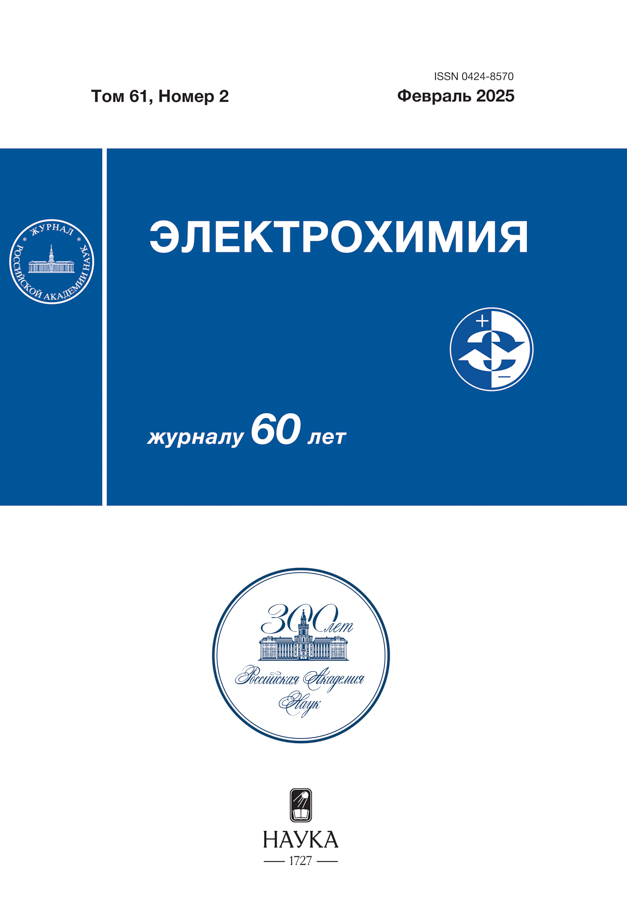卷 61, 编号 2 (2025)
Articles by participants of the All-Russian Conference “Electrochemistry-2023” (Moscow, October 23–26, 2023)
The Role of Iodine and Pyridine Bases in the Electrocatalytic Oxidation of Alcohols Mediated by 4-AcNH-TEMPO
摘要
The role of iodine, pyridine bases and nitroxyl radical (NR) – 4-AcNH-TEMPO in the electro oxidative transformation of alcohols to carbonyl compounds in a two-phase environment CH2Cl2/NaHCO3 (aq.) has been studied. Using the CV method, it was established that the iodide ion in a weakly alkaline medium (pH 8.6) is oxidized to active forms of iodine (I2 and I+), which are terminal oxidizers for NR capable of being converted into oxoammonium cations (OС), necessary for the oxidation of alcohol. Spectrophotometrically it has been established that pyridine bases are capable of stabilizing I2 and/or I+ in the form of [PyI2], [PyI]+ complexes, the formation of which occurs predominantly in the organic phase. Stabilized forms of iodine effectively convert NR into OC at the interface. The formation of a catalytic complex between OС and a pyridine base occurs in the aqueous phase. CV studies have shown that the rate of NR-mediated alcohol oxidation increases up to 4 times in the presence of a pyridine base, in contrast to the oxidative transformation without a pyridine base. This proves the advantages of the NR/pyridine base catalytic system and the role of the pyridine base as a promoter in the inderect electrooxidation of alcohols.
 129-139
129-139


Special issue based on the reports at the 17th International Meeting “Fundamental and Applied Problems of Solid State Ionics” (Chernogolovka, June 16–23, 2024)
Oxygen Mobility of Samarium Doped Neodymium Nickelates Sintered by E-Beams
摘要
Ruddlesden–Popper phases are known materials for electrochemical devices such as solid oxide fuel cells/electrolyzers, oxygen separation membranes. Doping A-site with lanthanides with less radii can allow to increase the oxygen mobility, however, this problem is still not studied well. This work aims at studying phase composition and transport properties of Sm doped Nd nickelates sintered by radiation-thermal technique using e-beams. Nd2–xSmxNiO4+δ (x = 0.2, 0.4) were synthesized by modified Pechini technique and sintered by e-beams at 1150–1250°C. The materials obtained were characterized by X-ray diffraction, X-ray photoelectron spectroscopy and temperature-programmed isotope exchange of oxygen with C18O2 in a flow reactor. The surface oxygen presents in two forms differing in binding energy. According to the temperature-programmed isotope exchange data, the samples possess nonuniformity in the oxygen mobility, and slow diffusion channel is present for the sample with x = 0.4. Such an oxygen diffusion features are probably related to the effect of doping with and radiation-thermal sintering on the structure with formation of admixed phases, hampering the cooperative migration due to emergence of local defects and variation of the surface and grain boundary composition.
 140-152
140-152


Regular articles
Magnetic Films Tremag Co–Ni–Fe
摘要
Magnetic films for creating magnetic field amplifiers must have a high magnetic permeability. The magnetization characteristics of electrochemically deposited Co–Ni–Fe films of variable composition are investigated using a magnetic force microscope at the nanometer scale. The difference in the magnetization of the samples is explained from the standpoint of the peculiarities of the local domain and crystallographic structure. We suppose that high magnetic permeability in weak magnetic fields is determined by the crystal lattice of the tremag Co60Ni20Fe20, in which the cells fcc and bcc are adjacent to each other.
 153-160
153-160


Barrier Layers Based on Refractory Metals in Contacts of High Temperature Thermoelements
摘要
An electrochemical method is proposed for forming contacts to high-temperature thermoelements with barrier layers based on refractory metal alloys. The contacts are intended for thermoelements with operating temperatures of up to 900 K. The barrier layers had a specific resistance of no more than 15.3 × 10–8 Ohm × m, and a specific contact resistance of no more than 1.5 × 10–9 Ohm m2. The best results were obtained for barrier layers based on Mo–Ni alloy with a Mo content of 36.5 wt. %. Ag films obtained by electrochemical deposition were used as a commutation layer in the contacts. It has been established that the contacts are thermally stable at the limiting operating temperatures of thermoelements and have an adhesive strength of at least 10.3 MPa.
 161-170
161-170











